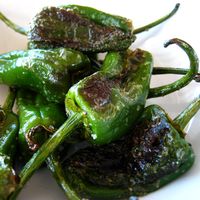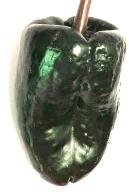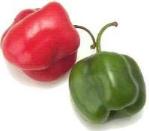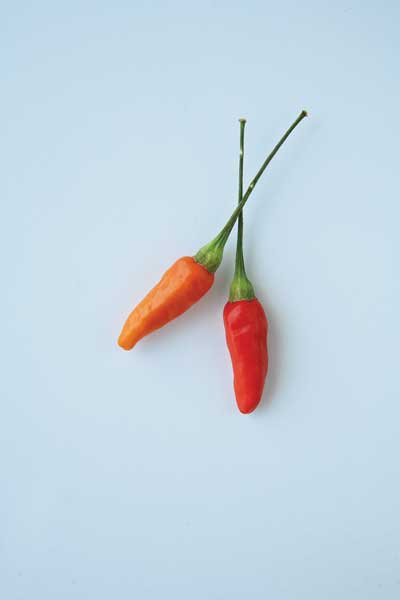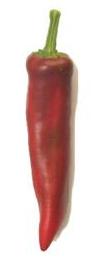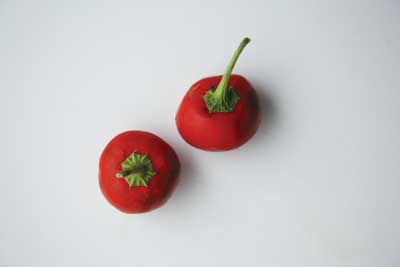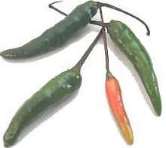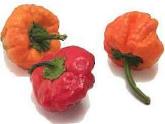Chilli Guide
Adapted from: missvickie.com & Saveur
There are many types of peppers used in ethnic dishes from
Mexico, the American Southwest, India and Asia all have local
varieties to compliment their national cuisine. The "hotness
of peppers is measured according to the Scoville Heat Index.
The mildest peppers such as sweet bell peppers and cherry
peppers are at the bottom of the Scoville scale. In the middle
are peppers like serrano, yellow hot wax peppers, and red
cayanne peppers. At the top of the scale are the habamero and
the Scotch Bonnet.
Peppers | |||
|
Common Names |
Photo |
Description |
Scoville Heat Units (SHU). |
|
Cherry Pepper, Hungarian Cherry Pepper, Bird Cherry Pepper, Creole Cherry Pepper |
|
Cherry peppers measure about 1 3/4 inch in diameter. The heat ranges from moderately mild to medium heat with traces of sweetness. Peppers are fleshy and heavily seeded. It matures from green to red.
|
100 - 500 |
|
NuMex Big Jim |
|
This stunning, foot-long pepper is one of many descendants of the New Mexico pod-type cultivars developed by the horticulturist Fabián García in the early 20th century. Easy to peel and mildly hot, it is ideal for stuffing or fire-roasting; it's also delicious roasted, cut into strips, and sprinkled with olive oil. (C. annuum.)
|
100 - 1000 |
|
Pimiento de Padrón |
|
Though these tiny, thin-skinned peppers hail from Spain, they were likely developed from Mexican seeds. Very tasty when fried in olive oil and sprinkled with coarse salt (see the recipe for Padrón Peppers with Serrano Ham), these peppers are generally mild, but it is not uncommon to find a few in a bunch that are hot enough to make you gasp. (C. annuum.)
|
500–2,500 |
|
Banana Pepper, Banana Chile, Sweet Banana Pepper, Pimento |
|
A banana-shaped pepper that changes from pale to deep yellow or orange as they mature. These are easily confused with hotter yellow wax peppers. Sample before using. Sweet banana peppers are sweet, long, tapered, yellow and banana-shaped, hence the name. Sweet Banana peppers may be fried or sautéed, used raw on relish platters, in salads, sandwiches or stuffed.
|
500 |
|
Poblano Pepper (Fresh), Ancho Chile(Dried Version)
|
|
When fresh it is called chili poblano, a large (about 4 inches long and 2½ inches wide) mild, heart-shaped pepper that has thick walls, which make them great for stuffing. Because it is a rather mild pepper, it can be used in quantity to add a deep rich flavor to any chili creation. They're best in the summer. Substitutes: Anaheim. Ancho is the dried version, and it has a brownish-red to chocolate color with a rich chili flavor.
|
2,000 |
| Pasilla |  |
The pasilla pepper is a long, thin pepper 7 to 12 inches long by 1 inch in diameter. Pasillas turn from dark green to dark brown as they mature. |
1,000 to 2,500 |
|
Anaheim Chile; California Green Chile; Long Green Pepper; Chile Verde; (When Mature And Red - Chile Colorado; California Red Chile) |
|
These large (5 to 8 inches long, 1 1/2 to 2 inches wide, tapering to a point), mild chiles have a thick skin, and are usually a bright, shiny green. Available year-round in most supermarkets, they're best in the summer. The flavor ranges from mild and sweet to moderate hot,they can vary greatly from pepper to pepper. They are perfect for chiles rellenos, dice or purée them for sauces, soups, and casseroles. Substitute: New Mexico green chile (very close, but hotter) OR poblano chilies. |
2,500 |
|
Rocotillo Chile |
|
These chiles look like tiny bell peppers and have black seeds. They have an interesting fruity flavor. Substitutes: manzana chile (very similar) OR habanero (similar heat) |
2,500 |
|
Mirasol Pepper |
|
This thin-skinned pepper can vary more than any other chile in looks, and therefore may be hard to recognize. Sometimes small, sometimes large, smooth or wrinkled, it is quite inconsistent. Known for its distinct berry like, fruity flavor that enhances potatoes chicken, and pork. Spices up hot salsas, stews, and mole sauces. |
2,500 - 5,000 |
|
Tabasco |
|
The tabasco pepper is the best-known domesticated variety of the C. frutescens species. It's not known when tabasco peppers first migrated north from Central America, but they are now inextricably associated with the Louisiana-made sauce of the same name. (C. frutescens.) |
2,500–8,000 |
|
Mexican Mirasol Pepper |
|
Not to be confused with the Andean ají mirasol, the Mexican mirasol is a moderately hot, three-inch-long chile that normally ripens to a bright red; a purple cultivar is shown here. Better known dried, in which case it is called guajillo, it adds sharpness and a bright color to cooked sauces. (C. annuum.) |
5,000 - 15,000 |
|
Cascabel |
|
A medium hot Mexican pepper. When mature, it is a burgundy red and, when dried, becomes very dark cherry like round & reddish brown with a translucent skin; the seeds rattle inside if shaken—which accounts for its name, which means jingle bell in Spanish.It has a dark reddish_brown color and the seeds rattle around inside, hence its name cascabel-or jingle bell. When toasted this pepper develops a rich nutty flavor. Fresh cascabels lend strong tannic notes to table salsas and cooked sauces. (C. annuum.) |
5,000 |
|
Fresno Pepper |
|
Bright green, changing to orange and red when fully matured, Fresno chilies have a conical shape - about 2 inches long and 1 inch in diameter at the stem end. Similar to jalapeno peppers, but with thinner walls, they're great in salsas. Fresnos are available in the summer. the hotter red ones come out in the fall. |
5,000 |
|
Jalapeño Pepper |
|
These popular chiles have a good amount of heat and rich flavor. Green jalapenos are best in the late summer, while red jalapenos appear in the fall. Canned jalapenos aren't as fiery as fresh. In the Mexican kitchen, the jalapeño is marinated in vinegary escabeches (pickling sauces), and cut it into strips (rajas) to give moderate heat to a variety of foods, including the filling for tamales. When the jalapeño is dried and smoked it becomes the complexly flavored chipotle. (C. annuum.) Substitutes: cuaresmeno (very similar) OR Fresno chile OR guero chile OR malagueta (hotter) OR serrano pepper OR yellow wax chile pepper OR fresh cayenne pepper |
5,000 |
|
New Mexico |
|
Light green when young, maturing to a medium green, and finally a deep red when left on the bush. In the fall, chili pepper fanatics throughout the Southwest crowd roadside roasting stands to stock their freezers with the new fall crop. Dried is probably the most common version available, but also available fresh and smoked dried while still green. Its heat range is from medium to hot and it has a very distinctive flavor. |
5,000 |
|
Chipotal, Dried Jalapeno Peppers |
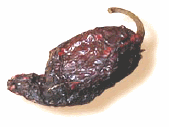 |
Chipotal is not actually a name for any particular pepper, but it applies to a smoking process to dry them. Usually mature jalapenos are selected to be smoked-dried, making them significantly hotter than the immature green pepper. Chipotals enhance and impart a wonderful smoky flavor. |
8,000 |
|
Chile de Árbol |
|
With its elegant curve and pointy tip, this two-and-a-half-inch-long, very hot Mexican chile has a smooth, brittle skin and clean taste. It is a favorite in table sauces made with tomatoes and tomatillos. We love the bold heat of dried chiles de árbol in hot chocolate. (C. annuum.) |
15,000 to 30,000 |
|
Serrano Pepper |
|
A small, rich, waxy green peppers change to orange and red as they mature. They are about 1 ½” long with thin walls and the smaller they are, the more kick they have. Substitutes: jalapeno (not as hot).) |
25,000 |
|
Cayenne Pepper = Finger Chili = Ginnie Pepper = Bird Pepper |
|
A wrinkled, very pungent thick fleshed fruit, 6 inches long and 1-1/4 inches in diameter, they are often used in Cajun recipes. . Very pungent, even when small. The Cayenne derived its name from the Cayenne district of French Guiana. Used for sauces, dried, pickled or in salsas. Green cayennes appear in the summer, while hotter red cayennes come out in the fall. Substitutes: chile de arbol OR Thai pepper OR habanero OR jalapeno OR serrano. |
60,000 |
|
Thai Chile = Bird Pepper = Thai Bird Chile = Pick Chi A = Thai Jalapeno |
|
For such a small chile, it packs an incredibly fiery punch. Thai chiles range in color from red to green when fully mature. They are often used in Asian curries. Thai peppers should be used sparingly. Substitutes: chile de Arbol OR fresh cayenne pepper OR jalapeno peppers (not as hot) OR Serrano peppers (not as hot) |
150,000 |
|
Scotch Bonnet Chile |
|
This chile is almost indistinguishable from the habanero, except that it's a bit smaller. It's popular in the Caribbean. Substitutes: habañero chile OR Serrano chilies (use twice as many) OR jalapeno peppers (use twice as many) |
325,000 |
|
Habanero Pepper |
|
For the uninitiated even a tiny piece of Habanero would cause intense and prolonged oral suffering. Underneath the heat is a delicate plum-tomato apple-like flavour. close relatives are Scotch Bonnet and Rocoto. |
325,000 to 570,000 |



